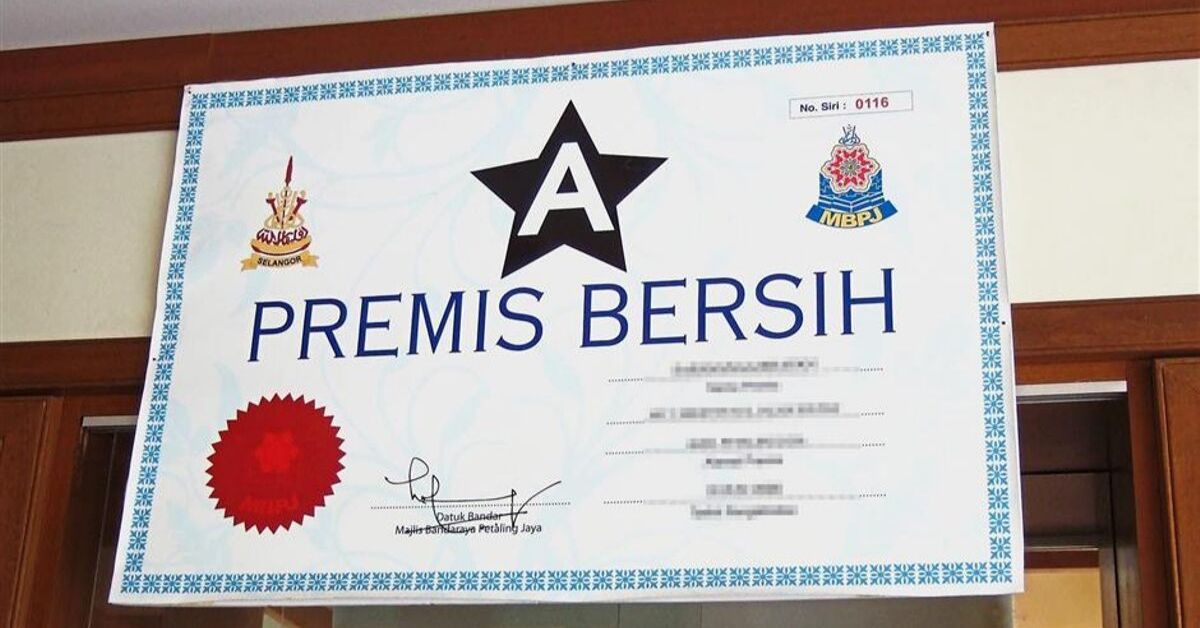Just last month, 7 restaurants in Selayang and Kepong were ordered to shut down due to rat and cockroach infestations and their generally filthy premises.
In July, there was also a video about a man in Port Dickson finding maggots in his fried chicken that went viral across social media. The restaurant where the incident took place was subsequently ordered to close temporarily.
We might depend a lot on Google reviews or reviews on other platforms like TripAdvisor to inform us of a restaurant’s cleanliness.
However, at the end of the day, the only ratings we can truly trust to inform us of an F&B establishment’s cleanliness are the grades plastered on their walls.
We’ve seen those A, B, and C grades on the walls of various restaurants and cafés. But what exactly do they tell us?
Not Just For Show
These grades exist for 2 reasons: to inform customers on the degree of a restaurant’s cleanliness, and to ensure that the F&B operators uphold their hygiene.
Malaysia has a regulation known as the Food Hygiene Regulations (FHR) 2009 which was established to protect consumers from food-borne diseases and to ensure that they can enjoy safe and quality food.

According to it, restaurants have to comply with specific rules in order to earn the proper certifications needed to operate.
To ensure that these restaurants keep up with the set standards, local health inspectors will carry out checks before assigning them a cleanliness grade.
Though checkups aren’t carried out on a fixed frequency, the City Council of Seberang Perai (MPSP) in Penang, for example, examines Grade A restaurants every 2 years, while those without a grade have 14 days to get themselves spick and span before a reassessment happens.
Score-Based Grading
Establishments are graded from a range of “A” for very clean, to a “D” or “no grade” for unclean. Like most bylaws, the grading system varies from one local council to another.
Despite that, these grades should still generally conform to similar standards, so here’s a general breakdown of how these grades are assigned to restaurants and what they all mean.
Restaurants will start off with 100 cleanliness points, and marks will be deducted every time a violation is exposed.
For example, in Petaling Jaya, restaurants must score 86 to 100 points for an A. Restaurants that score 71 to 85 points get a B grade, and C grades are for scores of 51 to 70 points. Restaurants that score under 50 points will be immediately shut down.
F&B establishments are examined and given points based on 9 aspects:
- Food handling methods,
- Food handlers (who require compulsory training),
- Equipment and utensils sanitation,
- Amount of water supply,
- Drainage (grease traps),
- Toilet facilities,
- Waste Disposal,
- And their floors, walls, ceilings and ventilation.
A restaurant can have the cleanest kitchen without a cockroach feeler in sight, but it might still be denied a grade if it doesn’t have tiled floors and walls, according to MPSP.
Some of the most common offences a restaurant commits include not having grease traps in place, having untrained food handlers without typhoid injections, and having rat droppings or cockroaches present in the premises.
The Price Of Poor Hygiene
The Ministry of Health dictates that if even one cockroach is found on an F&B’s premises, they’re liable to be shut down.
Alicia Kho, a Food Safety Advisor & Trainer from Magcolm Solutions Sdn Bhd, explained why. “Among the auditors, we have one formula. If one live cockroach can be found in a premise, we can associate that there is a minimum of 5,000 cockroaches in the premise.”
She added that this is because the few cockroaches one would find in the daytime are the “elderly” and slower ones, and the majority of them which are younger and faster will only emerge at night.

Compared to cockroaches or maggots in your food, finding hair in your food might seem like the lesser violation, but it’s still a form of contamination that you have the right to make a complaint about.
Restaurants that serve food contaminated with foreign objects and substances that are poisonous, harmful or otherwise injurious to health can be fined up to RM100,000 or have its handlers face imprisonment for a term not exceeding ten years, or both, depending on the severity of the offence committed.
What Can Consumers Do?
If two patients get food poisoning from the same eatery, it can be legally declared as an outbreak. However, the problem arises when you consider that someone who got food poisoning from an eatery in KL might live in Subang, and thus seek treatment at a Subang clinic.
With patients seeking treatment all over the place, medical records end up not correlating, and authorities will not be prompted to investigate that KL eatery.
The best thing to do is to report a restaurant’s poor hygiene straight to the authorities like the city council so they can perform spot checks and enforce clean-ups. You could also do this if you suspect a restaurant might be hiding its grade to stay open.

In a less direct approach, you can contact the National Consumer Complaints Centre who will handle your complaints and claims and relay them to authorities on your behalf.
When it comes to upkeeping restaurant and food hygiene, lodging a consumer complaint shouldn’t be seen as annoying or unnecessary. It helps keep both the F&B operators and the local authorities accountable for the benefit of us consumers.
- You can watch a video on this topic here.
Featured Image Credit: filepic, The Star









